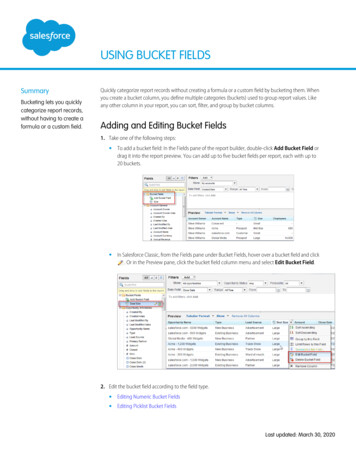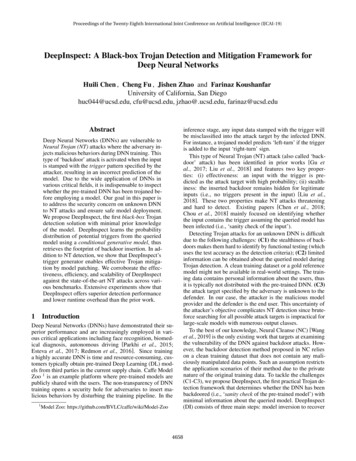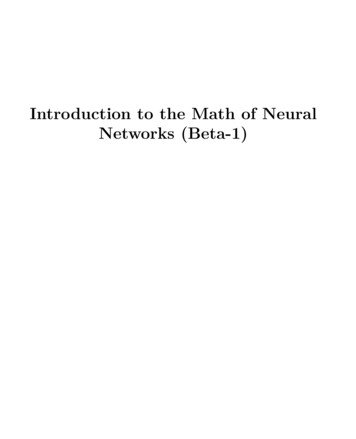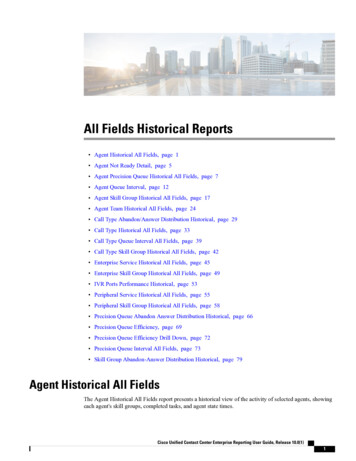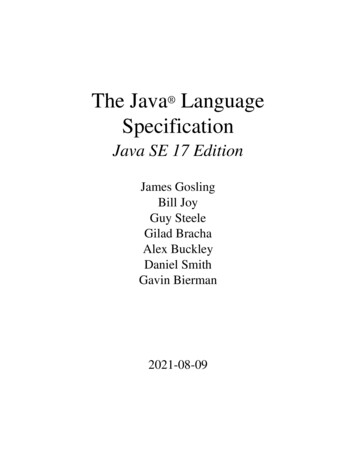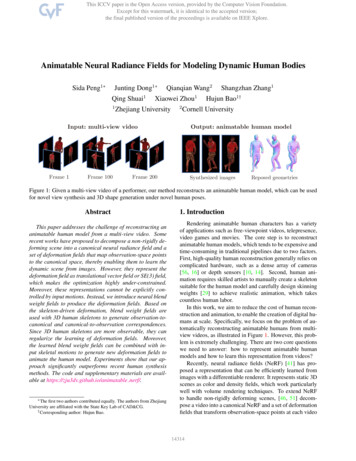
Transcription
Animatable Neural Radiance Fields for Modeling Dynamic Human BodiesSida Peng1 Junting Dong1 Qing Shuai11Qianqian Wang2Xiaowei Zhou1Zhejiang University2Frame 100Hujun Bao1†Cornell UniversityInput: multi-view videoFrame 1Shangzhan Zhang1Output: animatable human modelFrame 200Synthesized imagesReposed geometriesFigure 1: Given a multi-view video of a performer, our method reconstructs an animatable human model, which can be usedfor novel view synthesis and 3D shape generation under novel human poses.AbstractThis paper addresses the challenge of reconstructing ananimatable human model from a multi-view video. Somerecent works have proposed to decompose a non-rigidly deforming scene into a canonical neural radiance field and aset of deformation fields that map observation-space pointsto the canonical space, thereby enabling them to learn thedynamic scene from images. However, they represent thedeformation field as translational vector field or SE(3) field,which makes the optimization highly under-constrained.Moreover, these representations cannot be explicitly controlled by input motions. Instead, we introduce neural blendweight fields to produce the deformation fields. Based onthe skeleton-driven deformation, blend weight fields areused with 3D human skeletons to generate observation-tocanonical and canonical-to-observation correspondences.Since 3D human skeletons are more observable, they canregularize the learning of deformation fields. Moreover,the learned blend weight fields can be combined with input skeletal motions to generate new deformation fields toanimate the human model. Experiments show that our approach significantly outperforms recent human synthesismethods. The code and supplementary materials are available at https://zju3dv.github.io/animatable nerf/. The first two authors contributed equally. The authors from ZhejiangUniversity are affiliated with the State Key Lab of CAD&CG.† Corresponding author: Hujun Bao.1. IntroductionRendering animatable human characters has a varietyof applications such as free-viewpoint videos, telepresence,video games and movies. The core step is to reconstructanimatable human models, which tends to be expensive andtime-consuming in traditional pipelines due to two factors.First, high-quality human reconstruction generally relies oncomplicated hardware, such as a dense array of cameras[56, 16] or depth sensors [10, 14]. Second, human animation requires skilled artists to manually create a skeletonsuitable for the human model and carefully design skinningweights [29] to achieve realistic animation, which takescountless human labor.In this work, we aim to reduce the cost of human reconstruction and animation, to enable the creation of digital humans at scale. Specifically, we focus on the problem of automatically reconstructing animatable humans from multiview videos, as illustrated in Figure 1. However, this problem is extremely challenging. There are two core questionswe need to answer: how to represent animatable humanmodels and how to learn this representation from videos?Recently, neural radiance fields (NeRF) [41] has proposed a representation that can be efficiently learned fromimages with a differentiable renderer. It represents static 3Dscenes as color and density fields, which work particularlywell with volume rendering techniques. To extend NeRFto handle non-rigidly deforming scenes, [46, 51] decompose a video into a canonical NeRF and a set of deformationfields that transform observation-space points at each video14314
frame to the canonical space. The deformation field is represented as translational vector field [51] or SE(3) field [46].Although they can handle some dynamic scenes, they arenot suited for representing animatable human models dueto two reasons. First, jointly optimizing NeRF with translational vector fields or SE(3) fields without motion prior isan extremely under-constrained problem [51, 30]. Second,they cannot explicitly synthesize novel scenes given inputmotions for animation.To overcome these problems, we propose a novel motion representation named neural blend weight field. Basedon the skeleton-driven deformation framework [29], blendweight fields are combined with 3D human skeletons togenerate deformation fields. This representation has twoadvantages. First, since the human skeleton is easy to track[22], it does not need to be jointly optimized and thus provides an effective regularization on the learning of deformation fields. Second, by learning an additional neural blendweight field at the canonical space, we can explicitly animate the neural radiance field with input motions.We evaluate our approach on the H36M [19] and ZJUMoCap [49] datasets that capture dynamic humans in complex motions with synchronized cameras. Across all videosequences, our approach exhibits state-of-the-art performances on novel view synthesis and novel pose synthesis.In addition, our method is able to reconstruct the 3D humanshape at the canonical space and repose the geometry.In summary, this work has the following contributions: We introduce a novel representation called neuralblend weight field, which can be combined with NeRFand 3D human skeletons to recover animatable humanmodels from multi-view videos. Our approach demonstrates significant performanceimprovement on novel view synthesis and novel posesynthesis compared to recent human synthesis methods on the H36M and ZJU-MoCap datasets.2. Related workHuman reconstruction. Modeling human characters isthe first step of traditional animation pipelines. To achievehigh-quality reconstruction, most methods rely on complicated hardware [10, 14, 59, 11, 16]. Recently, some works[58, 44, 41, 32] have attempted to learn 3D representationsfrom images with differentiable renderers, which reducesthe number of input camera views and achieves impressive reconstruction results. However, they have difficultyin recovering reasonable 3D human shapes when the camera views are too sparse, as shown in [49]. Instead of optimizing the network parameters per scene, [42, 54, 67, 55]utilize networks to learn human shape priors from groundtruth 3D data, allowing them to reconstruct human shapesfrom even a single image.Human animation. Skeletal animation [29, 25] is a common approach to animate human models. It first creates ascale-appropriate skeleton for the human mesh and then assigns each mesh vertex a blend weight that describes howthe vertex position deforms with the skeleton. Skinnedmulti-person linear model (SMPL) [36] learns a skeleton regressor and blend weights from a large amount ofground-truth 3D meshes. Based on SMPL, some works[48, 24, 27, 21, 13] reconstruct an animated human meshfrom sparse camera views. However, SMPL only describesthe naked human body and thus cannot be directly usedto render photorealistic images. To overcome this problem, [3, 2, 4] apply vertex displacements to the SMPLmodel to capture the human clothing and hair. [61] proposes a 2D warping method to deform the SMPL modelto fit the input image. Recent implicit function-based methods [45, 40, 9] have exhibited state-of-the-art reconstructionquality. [18, 5] combine implicit function learning with theSMPL model to obtain detailed animatable human models.[12] combines a set of local implicit functions with humanskeletons to represent dynamic humans. [64] proposes toanimate occupancy networks with a linear blend skinningalgorithm. However, these methods all need the supervisionof 3D ground-truth data.Neural rendering. To reduce the requirement for the reconstruction quality, some methods [57, 60, 34, 62, 28] improve the rendering pipeline with neural networks. Basedon the advances in image-to-image translation techniques[20], [38, 8, 39] train a network to map 2D skeleton imagesto target rendering results. Although these methods cansynthesize photorealistic images under novel human poses,they have difficulty in rendering novel views. To improvethe performance of novel view synthesis, [57, 60, 62, 1,50, 65, 52] introduce 3D representations into the renderingpipeline. [60] establishes neural texture maps and uses UVmaps to obtain feature maps in the image space, which isthen interpreted into images with a neural renderer. [62, 1]reconstruct a point cloud from input images and learn a 3Dfeature for each point. Then, they project 3D features intoa 2D feature map and employ a network to render images.However, 2D convolutional networks have difficulty in rendering inter-view consistent images, as shown in [58].To solve this problem, [35, 44, 41, 31, 33] interpret features into colors in 3D space and then accumulate them into2D images. [35] uses 3D convolutional networks to producediscretized RGB-α volumes. Neural radiance fields (NeRF)[41] proposes to represent 3D scenes with color and densityfields, which works well with the volumetric rendering andgives state-of-the-art performances on novel view synthesis.[49] combines NeRF with the SMPL model, allowing it tohandle dynamic humans and synthesize photorealistic novelviews from very sparse camera views.14315
latent codeappearance codeviewing directionhuman skeletonEq. 4NeRFneural blendweight fieldlatent codeobservation spacecanonical spaceneural blendweight fieldFigure 2: Overview of our approach. Given a query point x in the observation space at frame i, we infer its blend weightwi (x) using a neural blend weight field that is conditioned on the latent code ψ i . Based on the blend weight and the humanskeleton, we can obtain the corresponding point x′ in the canonical space using equation (4). Taking the transformed pointx′ , observation-space viewing direction d, and appearance code ℓi as inputs, the template NeRF model predicts the volumedensity and color. To animate the template NeRF, we also learn a neural blend field wcan (x′ ) at the canonical space.3. MethodGiven a multi-view video of a performer, our task is toreconstruct an animatable human model that can be usedto synthesize free-viewpoint videos of the performer undernovel human poses. The cameras are synchronized and calibrated. For each frame, we assume the 3D human skeleton is given, which can be obtained with marker-based ormarker-less pose estimation systems [19, 22]. For each image, [15] is used to extract the foreground human mask, andthe values of the background image pixels are set as zero.The overview of our approach is shown in Figure 2.We decompose a non-rigidly deforming human body intoa canonical human model represented by a neural radiancefield (Section 3.1) and a per-frame blend weight field (Section 3.2) that is used to establish correspondences betweenthe observation space and canonical space. Then we discuss how to learn the representation on the multi-view video(Section 3.3). Based on blend weight fields, we are able toanimate the canonical human model (Section 3.4).3.1. Representing videos with neural radiance fieldsNeRF represents a static scene as a continuous volumetric representation. For any 3D point, it takes a spatial position x and viewing direction d as input to a neural networkand outputs a volume density σ and color c.Inspired by [46, 51], we extend NeRF to represent thedynamic human body by introducing deformation fields, asshown in Figure 2. Specifically, for each video frame i {1, ., N }, we define a deformation field Ti that transformsobservation-space points to the canonical space. Given thecanonical-frame density model Fσ , the density model atframe i can be thus defined as:(\sigma i(\mathbf {x}), \mathbf {z} i(\mathbf {x})) F {\sigma }(\gamma \mathbf {x}(T i(\mathbf {x}))), \label {eq:sigma}γx is the positional encoding [41] for spatial location.When predicting the color, we define a per-frame latentcode ℓi to encode the state of the human appearance inframe i. Similarly, with the canonical-frame color modelFc , the color model at frame i can be defined as:\mathbf {c} i(\mathbf {x}) F {\mathbf {c}}(\mathbf {z} i(\mathbf {x}), \gamma \mathbf {d}(\mathbf {d}), \boldsymbol {\ell } i), \label {eq:color}(2)where γd is the positional encoding for viewing direction.There are several ways to represent the deformation field,such as translational vector field [51, 30] and SE(3) field[46]. However, as discussed in [46, 30], optimizing a radiance field together with a deformation field is an ill-posedproblem that is prone to local optima. To overcome thisproblem, [46, 30] propose many regularization techniquesto facilitate the training, which makes the optimization process complex. Moreover, their representations cannot robustly generate new deformation fields given novel motionsequences.3.2. Neural blend weight fieldsConsidering that we aim to model dynamic humans, itis natural to leverage the human priors to learn the deformation field, which helps us to solve the under-constrainedproblem. Specifically, we construct the deformation fieldbased on the 3D human skeleton and the skeleton-drivendeformation framework [29].The human skeleton defines K parts, which produceK transformation matrices {Gk } SE(3). The detailedderivation is listed in the supplementary material. In the linear blend skinning algorithm [29], a canonical-space pointv is transformed to the observation space using\mathbf {v}' \left ( \sum {k 1} K w(\mathbf {v}) k G k \right ) \mathbf {v}, \label {eq:skinning}(3)(1)where zi (x) is the shape feature in the original NeRF, andwhere w(v)k is the blend weight of k-th part. Similarly, foran observation-space point x, if we know its corresponding14316
blend weights, we are able to transform it to the canonicalspace using\mathbf {x}' \left ( \sum {k 1} K w o(\mathbf {x}) k G k \right ) {-1} \mathbf {x}, \label {eq:inverse}(4)where wo (x) is the blend weight function defined in the observation space. To obtain the blend weight field, a naturalidea is to define a function that maps a 3D point to blendweights, which then gives the dynamic radiance fields basedon equations (1), (2) and (4). However, we find that jointlylearning NeRF with the blend weight field is still ill-posedand is prone to local minima.To solve this problem, we seek the human priors in 3Dstatistical body models [36, 53, 47, 63] to regularize thelearned blend weights. Specifically, for any 3D point, weassign an initial blend weight based on the body model andthen use a network to learn a residual vector, resulting in theneural blend weight field. In practice, the residual vectorfields for all training video frames are implemented using asingle MLP network F w : (x, ψ i ) wi , where ψ i isa per-frame learned latent code and wi is a vector RK .The neural blend weight field at frame i is defined as:\mathbf {w} i(\mathbf {x}) \text {norm}(F {\Delta \mathbf {w}}(\mathbf {x}, \boldsymbol {\psi } i) \mathbf {w} {\text {s}}(\mathbf {x}, S i)),(5)where ws is the initial blend weights that are computedbased on the statisticalbody model Si , and we definePnorm(w) w/ wi . Without loss of generality, we adoptSMPL [36] as the body model, which can be obtained byfitting the SMPL model to the 3D human skeleton [22].Note that this idea can also apply to other human models[53, 47, 63]. To compute ws , we take the strategy proposedin [18, 6]. For any 3D point, we first find the closest surfacepoint on the SMPL mesh. Then, the target blend weightis computed by performing barycentric interpolation of theblend weights of three vertices on the corresponding meshfacet.To animate the learned template NeRF, we additionallylearn a neural blend weight field wcan at the canonical space.The SMPL blend weight field ws is calculated using theT-pose SMPL model, and F w is conditioned on an additional latent code ψ can . We utilize the inherent consistencybetween blend weights to optimize the neural blend weightfield wcan , which will be described in Section 3.3.Instead of learning blend weight fields at both observation and canonical spaces, an alternative method is to onlylearn the blend weight field at the canonical space as inEquation (3), which specifies the canonical-to-observationcorrespondences. However, “inverting” Equation (3) to getobservation-to-canonical correspondences for rendering isnon-trivial. We would need to first build a dense set ofobservation-to-canonical correspondences by densely sampling points at the canonical space and evaluating theirblend weights. Then, for any observation-space point, wecan interpolate its corresponding canonical point based onthe pre-computed correspondences. This process is complex and time-consuming. Moreover, as the sampled pointsare discretized, the calculated correspondences tend to becoarse. In contrast, learning blend weights at observation spaces enables us to easily obtain the observation-tocanonical correspondences based on Equation (4).3.3. TrainingBased on the dynamic radiance field σi and ci , we canuse volume rendering techniques [23, 41] to synthesize images of particular viewpoints for each video frame i. Thenear and far bounds of volume rendering are estimated bycomputing the 3D boxes that bound the SMPL meshes. Theparameters of Fσ , Fc , F w , {ℓi } and {ψ i } are jointly optimized over the multi-view video by minimizing the difference between the rendered pixel color C̃i (r) and the observed pixel color Ci (r):L {\text {rgb}} \sum {r \in \mathcal {R}} \ \tilde {\mathbf {C}} i(\mathbf {r}) - \mathbf {C} i(\mathbf {r}) \ 2,(6)where R is the set of rays passing through image pixels.To learn the neural blend weight field wcan at the canonical space, we introduce a consistency loss between blendweight fields. As shown by equations (3) and (4), twocorresponding points at canonical and observation spacesshould have the same blend weights. For an observationspace point x at frame i, we map it to the canonical-spacepoint Ti (x) using equation (4). The consistency loss between blend weight fields is defined as:L {\text {nsf}} \sum {\mathbf {x} \in \mathcal {X} i} \ \mathbf {w} i(\mathbf {x}) - \mathbf {w} {\text {can}}(T i(\mathbf {x})) \ 1,(7)where Xi is the set of 3D points sampled within the 3Dhuman bounding box at frame i. The coefficient weights ofLrgb and Lnsf are both set to 1.3.4. AnimationImage synthesis. To synthesize images of the performerunder novel human poses, we similarly construct the deformation fields that transform the 3D points to the canonical space. Given a novel human pose, our method updatesthe pose parameters in the SMPL model and computes theSMPL blend weight field ws based on the new parametersS new . Then, the neural blend weight field wnew for the novelhuman pose is defined as:(8)where the F w is conditioned on a new latent code ψ new .Based on the wnew and equation (4), we can generate the14317
deformation field T new for the novel human pose. The parameters of ψ new are optimized usingL {\text {new}} \sum {\mathbf {x} \in \mathcal {X} {\text {new}}} \ \mathbf {w} {\text {new}}(\mathbf {x}) - \mathbf {w} {\text {can}}(T {\text {new}}(\mathbf {x})) \ 1, \label {eq:lnew}(9)where X new is the set of 3D points sampled within the human box under the novel human pose. Note that we fix theparameters of wcan during training. In practice, we trainneural skinning fields under multiple novel human poses simultaneously. This is implemented by conditioning F won multiple latent codes. With the deformation field T new ,our method uses equations (1) and (2) to produce the neuralradiance field under the novel human pose.3D shape generation. In addition to synthesizing imagesunder novel human poses, our approach can also explicitlyanimate a reconstructed human mesh, similar to the traditional animation methods. In particular, we first discretizethe human bounding box at the canonical space with a voxelsize of 5mm 5mm 5mm and evaluate the volume densities for all voxels, which are used to extract the humanmesh with the Marching Cubes algorithm [37]. Then, blendweights of mesh vertices are inferred from the neural blendweight field wcan . Finally, given a novel human pose, weuse equation (3) to transform each vertex, resulting in a deformed mesh under the target pose. The reconstruction results are presented in the supplementary material.4. Implementation detailsThe networks of our radiance field Fσ and Fc closelyfollow the original NeRF [41]. We only use the single-levelNeRF and sample 64 points along each camera ray. Thenetwork of F w is almost the same as that of Fσ , except thatthe final output layer of F w has 24 channels. In addition,F w applies exp(·) to the output. The details of networkarchitectures are described in the supplementary material.The appearance code ℓi and blend weight field code ψ i bothhave dimensions of 128.Training. Our method takes a two-stage trainingpipeline. First, we train the parameters of Fσ , Fc , F w ,{ℓi } and {ψ i } jointly over the input video. Second, neuralblend weight fields under novel human poses are learnedusing equation (9). The Adam optimizer [26] is adopted forthe training. The learning rate starts from 5e 4 and decaysexponentially to 5e 5 along the optimization. The trainingis conducted on four 2080 Ti GPUs. For a three-view videoof 300 frames, the first stage training takes around 200k iterations to converge (about 12 hours). For 200 novel humanposes, the second stage training takes around 10k iterationsto converge (about 30 minutes).5. Experiments5.1. Dataset and metricsH36M [19] records multi-view videos with 4 cameras andcollects human poses using the marker-based motion capture system. It includes multiple subjects performing complex actions. We select representative actions, split thevideos into training and test frames, and perform experiments on subjects S1, S5, S6, S7, S8, S9, and S11. Threecameras are used for training and the remaining camera isselected for test. We use [22] to obtain the SMPL parameters from the 3D human poses and apply [15] to segmentforeground humans. More details of training and test datacan be found in the supplementary material.ZJU-MoCap [49] records multi-view videos with 21 cameras and collects human poses using the marker-less motion capture system. For evaluation, we select four representative sequences: “Twirl”, “Taichi”, “Warmup”, and“Punch1”. Four uniformly distributed cameras are used fortraining and the remaining cameras for testing. We followthe experimental protocol in [49].Metrics. Following typical protocols [41], we evaluateour method on image synthesis using two metrics: peaksignal-to-noise ratio (PSNR) and structural similarity index(SSIM). For 3D reconstruction, since there is no groundtruth geometry, we only provide qualitative results, whichcan be found in the supplementary material.5.2. Performance on image synthesisBaselines. We compare with state-of-the-art image synthesis methods [60, 62, 49] that also utilize SMPL priors. 1)Neural Textures [60] renders a coarse mesh with latent texture maps and uses a 2D CNN to interpret feature maps intotarget images. Since [60] is not open-sourced, we reimplement it and take the SMPL mesh as the input mesh. 2) NHR[62] extracts 3D features from input point clouds and renders them into 2D feature maps, which are then transformedinto images using 2D CNNs. Since dense point clouds aredifficult to obtain from sparse camera views, we take SMPLvertices as input point clouds. 3) Neural body [49] represents the human body with an implicit field conditioned onthe latent codes anchored on the vertices of SMPL and renders the images using volume rendering.Results of novel view synthesis. For comparison, wesynthesize novel views of training video frames. Table 1shows the comparison of our method with [60, 62]. Specifically, our model outperforms [60, 62] by a margin of atleast 2.07 in terms of the PSNR metric and 0.024 in terms ofthe SSIM metric. Moreover, the proposed method achievescomparable results with the most recent state-of-the-art approach [49] as shown in Table 2, despite not being specifically designed for the novel view synthesis task.14318
Ground TruthNeural TexturesNHROursGround TruthNeural TexturesNHROursFigure 3: Qualitative results of novel view synthesis on the H36M dataset. [60, 62] have difficulty in controlling theviewpoint and seem to overfit training views. Compared with them, our method accurately renders the target view.S1S5S6S7S8S9S11averageNT R .0523.2721.1322.5022.7524.7224.5523.00NT R 8880.8920.8540.8900.8980.9080.9020.890Table 1: Results of novel view synthesis on H36M datasetin terms of PSNR and SSIM (higher is better). “NT”means Neural Textures.novel viewnovel poseNT[60]22.6121.55PSNRNHRNB[62][49]23.25 28.9021.88 9]0.905 0.9670.863 0.879Ours0.9490.893Table 2: Results of novel view synthesis and novel posesynthesis on ZJU-MoCap dataset in terms of PSNR andSSIM (higher is better). “NB” means Neural Body.Figure 3 presents the qualitative comparison of ourmethod with [60, 62]. Both [60, 62] have difficulty in controlling the rendering viewpoint and tend to synthesize contents of training views. As shown in the second person ofFigure 3, they render the human back that is seen duringtraining. In contrast, our method is able to accurately control the viewpoint, thanks to the explicit 3D representation.Results of novel pose synthesis. For comparison, we synthesize test video frames from the test camera view. Table 3compares our method with [60, 62] in terms of the PSNRmetric and the SSIM metric. For both metrics, our methodgives the best performances. Table 2 shows that our modelalso outperforms [49] when generating images under novelhuman poses on ZJU-MoCap dataset.S1S5S6S7S8S9S11averageNT R .3722.2922.5922.2221.7823.7223.9122.55NT R 8680.8750.8840.8780.8820.8860.8890.880Table 3: Results of novel pose synthesis on H36M datasetin terms of PSNR and SSIM (higher is better). “NT”means Neural Textures.The qualitative results are shown in Figure 4. For complex human poses, [60, 62, 49] give blurry and distortedrendering results. In contrast, synthesized images of ourmethod achieve better visual quality. The results indicatethat our model has better controllability on the image generation process than CNN-based methods.5.3. Ablation studiesWe conduct ablation studies on one subject (S9) of theH36M [19] dataset in terms of the novel pose synthesis performance. First, to analyze the benefit of learning F w , wecompare neural blend weight field with SMPL blend weightfield. Then, to explore the influence of human pose accuracy, we estimate SMPL parameters from predicted humanposes [7, 22] and perform training on these parameters. Finally, we explore the performances of our method under different numbers of video frames and camera views. Tables4, 5, 6, and 7 summarize the results of ablation studies.Impact of neural blend weight field. Table 4 shows thequantitative comparisons, which indicate that neural blendweight field performs better than SMPL blend weight field.14319
Ground TruthNeural TexturesNHROursGround TruthNHRNeural BodyOursFigure 4: Qualitative results of novel pose synthesis on the H36M and ZJU-MoCap datasets. For complex human poses,[60, 62, 49] tend to generate distorted rendering results. In contrast to them, our method has a better generalization ability.Marker-based pose estimationMarker-less pose estimationPSNR23.7222.27SSIM0.8860.858Table 5: Comparison between models trained with human poses from marker-based and marker-less pose estimation methods on subject “S9”.SubjectFrontFigure 5: Visualization of the residual vector field F won the reconstructed geometries of subjects “S9” and “S6”.Red means large residual. Best viewed in color.Neural blend weight fieldSMPL blend weight 0Table 4: Comparison between neural blend weight fieldand SMPL blend weight field on subject “S9”.To better show the improvement on the SMPL blendweight field, Figure 5 visualizes the residual vector fieldF w on our reconstructed geometry at the canonical space.The bigger residual has a redder color. We can see that regions of big residual mainly locate on the neck, hand, chest,and pants, which are human-specific details that SMPL cannot describe. The results indicate that our learned F w arephysically interpretable.Impact of the human pose accuracy. Table 5 comparesthe models trained with human poses from marker-basedand marker-less systems. The results show that more accurate human poses produce better rendering quality. Thequalitative comparison is presented in Figure 75Table 6: Results of models trained with different numbers of video frames on subject “S9” of H36M dataset.Impact of the video length. For comparison, we take 1,100, 200 and 800 video frames for training and test the models on the same motion sequence. Table 6 lists the quantitative results of our models trained with different numbersof video frames. The results demonstrate that training onthe video helps the representation learning, but the networkseems to have difficulty in fitting very long videos. Empirically, we find that 150 300 frames are suitable for mostsubjects. Figure 7 presents the qualitative comparisons.Impact of the number of input views. For comparison, we take one view for test and select 1, 2, and 3 nearestviews for training. Table 7 compares the performances ofmodels trained with different numbers of input views. Surprisingly, the three models have similar quantitative performances. Figure 8 further compares the three models, whichshows that the model trained on 3 views renders mor
to synthesize free-viewpoint videos of the performer under novel human poses. The cameras are synchronized and cal-ibrated. For each frame, we assume the 3D human skele-ton is given, which can be obtained with marker-based or marker-less pose estimation systems [19,22]. For each im-age, [15] is used t




